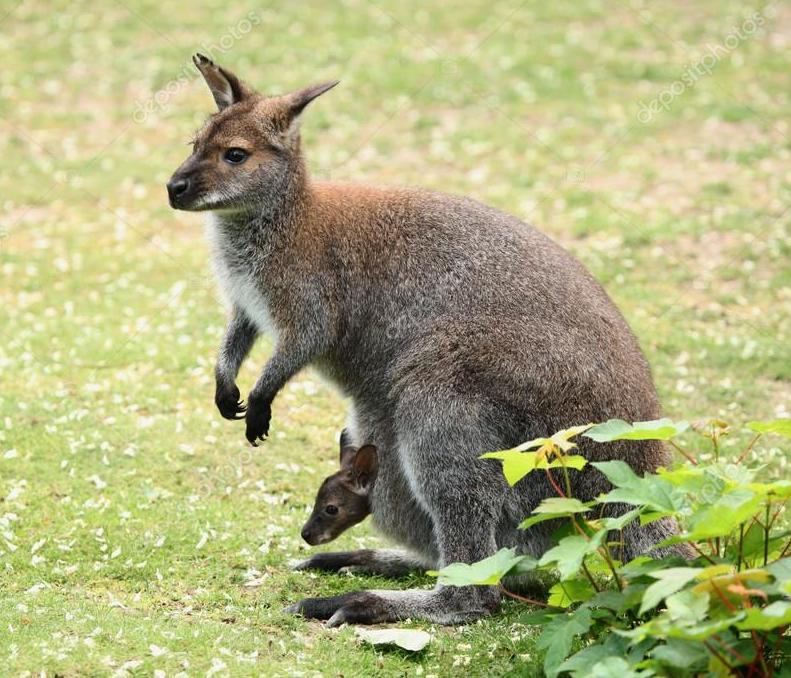Basic Care: Wallabies

Wallabies are charismatic wild marsupials native to Australia and New Guinea. Wallabies belong to the family of Macropods (meaning long foot) which consist of wallabies, kangaroos, kangaroo rats. Common captive species include the Bennet’s/red-necked wallaby (Macropus rufogriseus) and Agile wallaby (Macropus agilis). Adult wallabies range in height from 2-3 feet and weigh between 30-50 lbs (depending on species). If kept appropriately, these animals can live 12-15 years in captivity.
Food and Water
Both Bennet’s and Agile wallabies are foregut fermenters that require a diet high in fiber and access to unlimited clean water. A healthy diet consists of unlimited access to high-quality grass hay (Timothy, orchard, and Bermuda grass are some recommendations). This should make up 75-80% of their diet. Wallaby pellets should make up 15-20% of the diet (we recommend Mazuri Kangaroo/Wallaby diet) and the remaining 5% should be fresh vegetables and some fruit as treats (spring mix lettuce, carrots or apples). Avoid high sugar fruits (grapes, oranges, bananas, etc.) or high volumes of fresh produce as this can cause GI upsets. Enclosures should be checked for any naturally growing toxic plants (please seek veterinary advice when evaluating toxic plants in Arizona).
Feed and water should be provided in a manner that is free from contamination with urine or feces. This can be achieved by having elevated troughs for feed. These containers should be cleaned of any left-over produce or pellets to prevent bacteria or fungal growth that could lead to disease.
Housing
Wallabies are wild animals, thus housing and enclosures should mimic the natural history for the species.
At a minimum, a single individual should have an outdoor enclosure that is 50 x 50 feet. Ideally up to one acre of fenced space is recommended. This allows for natural foraging behaviors, plenty of room for exercise and enrichment. Outdoor enclosures should be lined with grass, sand or and be contained by a fence 6-8 feet tall. When constructing an outdoor enclosure, the inside of the enclosure should be as smooth as possible. Meani
ng all posts and fasteners should be on the outside of the fence, as these individuals are prone to fence running and can traumatize themselves on fences or fasteners. If chain link or chicken wire fence is to be used ensure that the mesh is small enough to prevent pets from becoming stuck in the links. Enclosures should also be secure from rodents, felines (cats and bobcats) and any native predators. Wallabies are adaptable to a wide range of temperatures but will require supplemental heat when temperatures fall below 50 degrees Fahrenheit. They should also be provided with shade or supplemental cooling when temperatures are above 90 degrees Fahrenheit. Outdoor shelters should be provided as a retreat from environmental extremes. These can be barns, small outbuildings, appropriately sized dog houses, or lean-to shelters. If housing indoors at night wallabies should have their own secure room or large enclosure that is free of furniture or other items they can destroy or harm themselves with.
Handling Tips
Wallabies, like other macropods, have powerful hind limbs and tails that they use to quickly get from point A to point B. These limbs are also used to deliver powerful kicks when these animals feel threatened. Most young wallabies can be socialized through positive exposure at a young age. However, some individuals may resort to wilder habits with age. Indicators that a wallaby is becoming stressed include stomping, rearing back on the tail and audible grunting. If these warning signs are displayed the animal may attempt to kick. Young animals are amenable to transport in a cloth pouch, while adults need to be transported in an appropriately sized dog crate. It is recommended to use positive reinforcement to train your wallaby to enter and exit a crate.
Preventative Medicine
Yearly veterinary visits are recommended to keep captive wallabies in top condition. Common medical problems include but are not limited to tetanus, toxoplasmosis, coccidiomycosis (valley fever), salmonellosis, vitamin deficiencies, and others. As such preventative medicine consists of yearly physical exams, recommended vaccinations, and fecal screening to treat parasitism.
As with other pets if you Wallaby is showing signs of lethargy, reduced appetite, diarrhea, facial swelling, reduced appetite, sneezing, coughing or difficulties breathing it is recommended that you seek veterinary care as soon as possible as these can be life threatening situations.
NOTE: We at Arizona Exotic Animal Hospital do not encourage ownership of wallabies, especially without thorough research into the amount of time, space, energy, and financial investment they require. However, as they are legal in the state of Arizona to own, we want to provide a resource for appropriate care of one in captivity.



